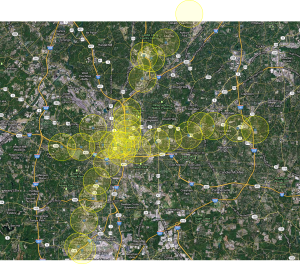Research
I would like to thank all those at RideCell (www.ridecell.com) for their help in this ongoing research.
Recent Update (Feb 15):
Check out my poster from the Georgia Tech Research and Innovation Conference on February 7th.
Solving Atlanta’s Last-Mile Transit Problem using the Network-Inspired Transportation System
The poster is an explanation of the NITS demand-responsive transportation system and explains how it can be used to improve Atlanta’s transit system (MARTA). I am hard at work finishing the Atlanta NITS simulator and expect to be cranking out results in the next few days.
Motivation
Sitting on my front porch in Atlanta, I would watch the same bus pass in front of my house every 40-60 minutes. It was almost always empty, and I never saw more than 5 or so people on the bus. This was wasteful and inefficient for everyone. For MARTA, running low-occupancy or empty buses is costly. For passengers, a bus that only runs every 40-60 minutes is not very useful. This is a common problem in cities like Atlanta, Houston, Los Angeles, and others that do not have the population density to support high frequency bus service.
The Network-Inspired Transportation System
In cities or areas with low-density traditional static route transportation does not work well, and with the ubiquity of mobile phones and easy communication, there is no need to rely on this type of transit. If a passenger can communicate his or her destination and current location to the transit operator (similar to calling a taxi, except without the need to directly talk to a dispatcher) then the transit company should be able to create optimal bus paths in real time to better serve customers.
This concept is known as dial-a-ride and has been around since the 70’s in theory and in limited use as paratransit operations. The reasons that it has not caught on are because the technology is only just now reaching the level to effectively use demand-responsive systems, and an effective framework has not been created for handling thousands of ride requests across an entire metropolitan region.
When thousands of ride requests are being required simultaneously, a effective system of assigning the trips to the proper vehicles and routing those vehicles is imperative. The assignment and routing problem will become overwhelming very quickly, even for the most advanced super-computers. The NITS, described in detail here, is an attempt to break apart this daunting task into many smaller optimization problems that can be more easily solved. It is inspired by the way in which billions of data packets are transmitted through a telecommunication networks, hence the name Network-Inspired Transportation System. The image below illustrates the corresponding analogies between a the NITS system and a telecommunications network.
In the NITS, instead of trying to solve a city-wide optimization problem, the city is divided into dozens or even hundreds of subnets linked together by static transit (such as rail and bus). When a passenger requests a ride across the city, he will be carried via an on-demand vehicle from his starting location, to an appropriate train or bus station. From there the bulk of the journey will be handled with conventional transit. Finally, once he reaches the train or bus station nearest his destination, the “last mile” of his journey will be handled via demand-responsive transit.
Current Status of the Research
The current research is in developing a NITS simulator where one can upload a street diagram of a real city, assign a transit layout and schedule, and then observe how an on-demand system that leverages existing transit infrastructure will behave. The tool is intended to help transit engineers determine where and how on-demand transit can be implemented. Furthermore, the simulator will be implementable. This means that the algorithms and technology developed for the simulator can be directly ported to on-board GPS devices and immediately used in a real-world NITS application.
Publications and Documents
October 2011 – NITS, IEEE Intelligent Transportation Society Conf. Oct 2011 and presentation.
March 2011 – Ph.D. Proposal – Georgia Institute of Technology



Really interesting stuff. I am familiar with the Dial-A-Ride Problem, and used to work on it extensively.
Good luck with your research and the thesis! 🙂